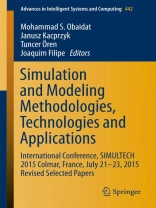The present book includes a set of selected extended papers from the 5th International Conference on Simulation and Modeling Methodologies, Technologies and Applications (SIMULTECH 2015), held in Colmar, France, from 21 to 23 July 2015. The conference brought together researchers, engineers and practitioners interested in methodologies and applications of modeling and simulation. New and innovative solutions are reported in this book. SIMULTECH 2015 received 102 submissions, from 36 countries, in all continents. After a double blind paper review performed by the Program Committee, 19% were accepted as full papers and thus selected for oral presentation. Additional papers were accepted as short papers and posters. A further selection was made after the Conference, based also on the assessment of presentation quality and audience interest, so that this book includes the extended and revised versions of the very best papers of SIMULTECH 2015. Commitment to high quality standards is a major concern of SIMULTECH that will be maintained in the next editions, considering not only the stringent paper acceptance ratios but also the quality of the program committee, keynote lectures, participation level and logistics.
İçerik tablosu
Numerical Assessment of Rubber Insulated Electric Cables Plants Eciency using Nitrogen and Steam Water as Curing Agents.- Simulation Driven Policy Recommendations for Code Diversity.- Multiple Runs in the Simulation of Stochastic Systems can Improve the Estimates of Equilibrium Expectations.- Io T Ecient Design using WCOMP Framework and Discrete Event Modeling and Simulation.- Comparison of System Dynamics and Discrete Event Simulation Approaches.- Applying Petri Nets to Coalition Formation Modeling.- Virtualization Guided Tsunami and Storm Surge Simulations for Lowc Power Architectures.- High Precision Temperature Control for Injector Components of a Free-Electron Laser.- Agent-based Wiki Page Simulation: A Conceptual Model.- Enabling Military Coalition Command and Control with Interoperating Simulations as a System of Systems.












